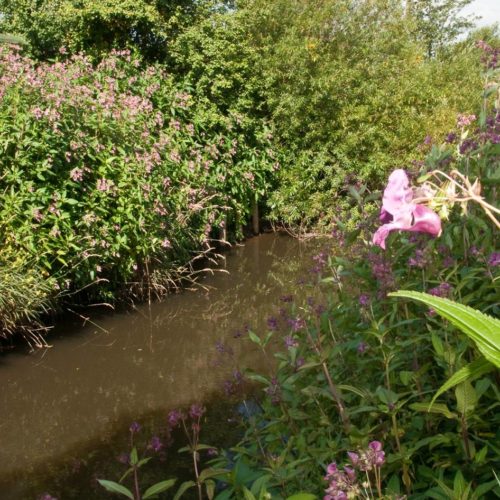
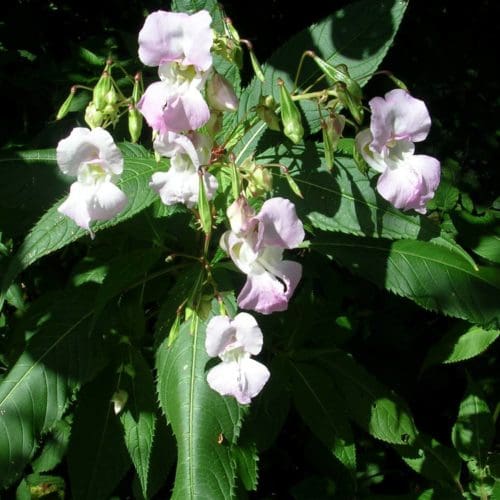

Himalayan Balsam (Impatiens glanulifera) AKA: Policeman’s Helmet, Indian Balsam, Jac y Neidiwr (Welsh). Colloquially known as Bee-bums, Poor Man’s orchid, Jumping Jacks and Stinky Pops.
Himalayan balsam ID Sheet (GB NNSS)
Himalayan balsam Good Practice Management Guide (RAPID)
Balsam Action Toolkit – for Community Action Groups (Wye Valley AONB)
Himalayan balsam is an attractive looking plant, with a stout, hollow stem, trumpet shaped pink/white flowers and elliptical shaped green leaves.
Introduced to Kew Gardens from Kashmir in 1839, it spread via its seeds – both individuals passing the seed on to other gardeners or beekeepers and seeds floating down rivers, lodging in muddy banks and germinating. It is now widespread across the UK’s lowlands and is ranked high on the list of Europe’s worst invasive plants.
A relative of the Busy Lizzie, this is our tallest annual at 2-3 metres (6-10ft) in height, with masses of sweet smelling pink/purple flowers (July – Oct). Its explosive seedpods fire hundreds of viable seeds up to 7 metres away, enabling it to colonise new areas of countryside incredibly quickly. Its seeds are easily transported via water, but also by animals and humans.
It has the highest growth rate of any plant in the herb layer, tolerating a wide range of conditions and growing to dominate an area in just one season. It particularly thrives in moist, semi-shaded damp places such as banksides by slow-moving watercourses.
Himalayan balsam is listed under Schedule 9 to the Wildlife and Countryside Act 1981 with respect to England and Wales. As such, it is an offence to plant or allow this species to grow in the wild.
Himalayan balsam is our most dominant invasive plant in the Wye Valley AONB. It has taken over long stretches of the River Wye and tributary banks – our most ecologically sensitive areas. It is also establishing itself in gardens, fields and woodlands, growing along culverts, footpaths and roads.
This plant is termed a transformer, altering ecosystems over large areas, and has also been described as a “back-seat driver” of change with ecological changes – disturbances, alteration in nutrients, pollution – facilitating its invasion, paving the way for it to become a driver of future change.
Some of the negative impacts:
References collated by Coakley, S.; Petti, C. July 2021 in ‘Impacts of the Invasive Impatiens glandulifera: Lessons Learned from One of Europe’s Top Invasive Species.’ Biology 2021, 10, 619. https://doi.org/10.3390/biology10070619.
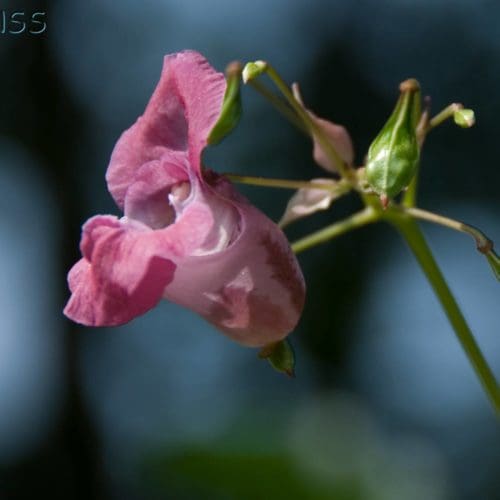

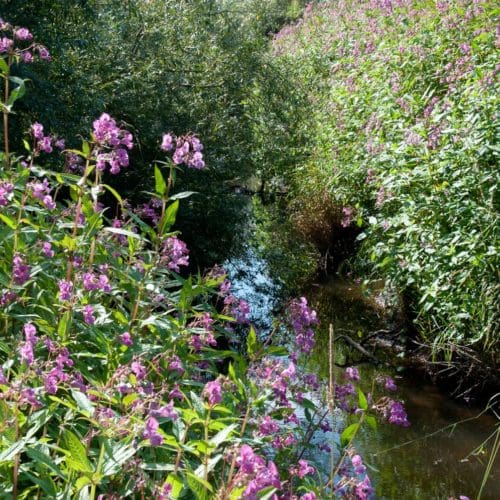

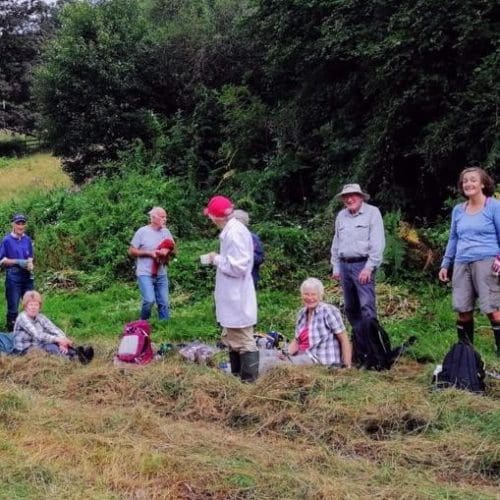

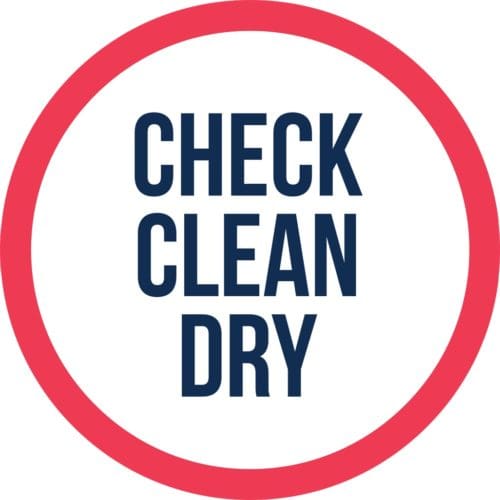

‘Prevention is better than cure’ and that couldn’t be more true than in the case of invasive species. So, we’ve been developing information and tools that will raise public awareness and understanding of the dangers of INNS, and specifically our target 3 plant species, to try to prevent further spread. We are joining the GB Non-Native Species Secretariat’s Invasive Species Week during which we’ll be running a social media campaign and two Balsam Training Days (including balsam bashing sessions) in Tintern and Llandogo for residents and community groups. Do have a look at our News & Events page for info.
In response to the many questions we get asked and see across social media about balsam every summer – ‘what can we do?’, ‘where can we do it?’, ‘what is the best method?’ – we’ve worked with community groups to develop a Balsam Action Toolkit designed to support community groups in taking action. We hope this will be used by existing groups and also inspire communities to set up action groups and organise balsam control events.
Community action at its best – as we know, the key with balsam is to reduce the risk of re-infestation and because the seeds are readily carried by water, this requires us to look at a catchment scale and work from the headwaters towards the sea. Since the AONB team is unable to coordinate at the full Wye catchment scale (the AONB boundary lies to the south of Hereford), we’re focusing on our local sub-catchments, controlling it from the headwaters down towards the main river. We know this is achievable because the brilliant volunteer group, The Narth & District Footpath Group, have piloted this approach since 2018 and have eradicated it from much of their catchment. They’re now working with Natural Resources Wales to clear the remaining very steep woodlands that lead towards the main river. It certainly proves ‘where there is a will, there is a way’. We will continue to support The Narth & District Footpath Group, and we are looking to extend this proven, community-led approach to further sub-catchments.
Community Balsam Bashing – Over 4 days at Brockweir last August we invited willing volunteers to join us for a Big Balsam Bash along the main river and adjacent wildflower meadows between Brockweir and Bigsweir and map the extent of balsam and other species in the upper reaches of the local sub-catchments. The events were a resounding success clearing a large area, helping to raise awareness and locate new sites to add to our action plan. Keep an eye on our News & Events page to see what’s coming up!
The good news is that Himalayan balsam is easy to pull up. Download our handy Practical Guide to Balsam Bashing from our Balsam Action Toolkit (see section 2) for valuable tips on how best to deal with it and how to organise a community event.
It’s critical that balsam pulling/bashing is done before the seed pods are ripe, and ideally before they start to flower. So, May – July is the optimal time. Bear in mind, follow up work is likely to be needed as the change in light levels is likely to stimulate seedlings to sprout up.
Try not to get dismayed! Remember, every single plant pulled up means there’s between 500-2,500 less seeds germinating next year.
If you see Himalayan balsam in your garden or along Public Rights of Way – May, June and July (even into early August depending on the growing rate) – get pulling up those plants! If you see it growing in a neighbour’s garden, gently point it out to them and offer to help them remove it. If you know a local landowner who’s struggling with controlling it, mobilise your friends and neighbours to support them with tackling it. Undoubtedly, community spirit will be the key to getting this species under control.
If you fancy bringing together your neighbours to balsam-pull along your local paths or at a local site, or forming a group to tackle balsam at community-scale then do have a look at our Balsam Action Toolkit and get in touch with us.
Later in the season – August onwards – do think about those exploding seed pods. If you’re walking, running or biking through balsam-infested areas please brush off your shoes and tyres before entering an area that is balsam-free. The seeds readily stick to boot soles, bike tyres etc. and wouldn’t it be awful if we as individuals were helping to perpetuate the problem!
Remember the mantra: Check, Clean, Dry.
Photos courtesy of NNSS Home – GB non-native species secretariat (nonnativespecies.org)